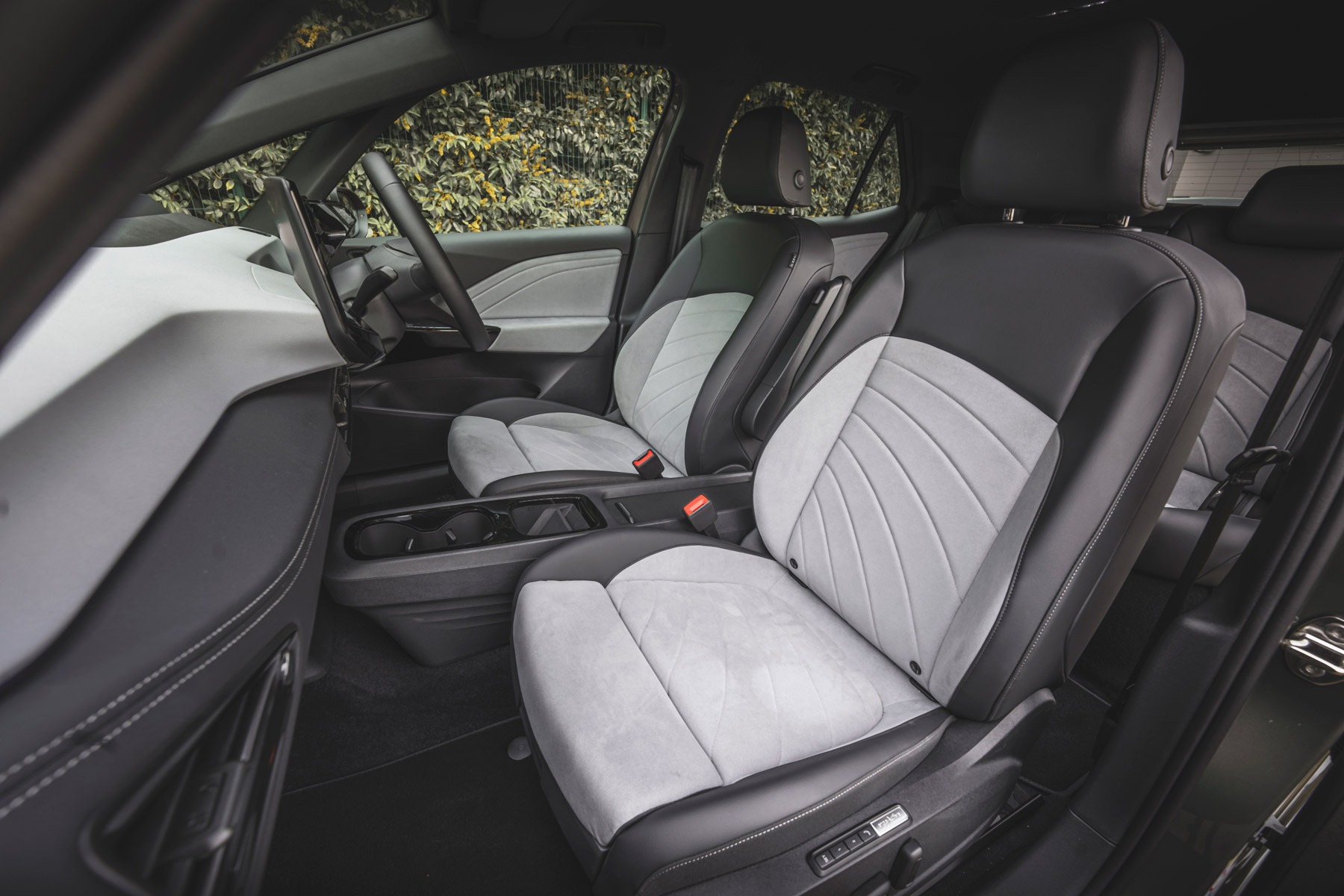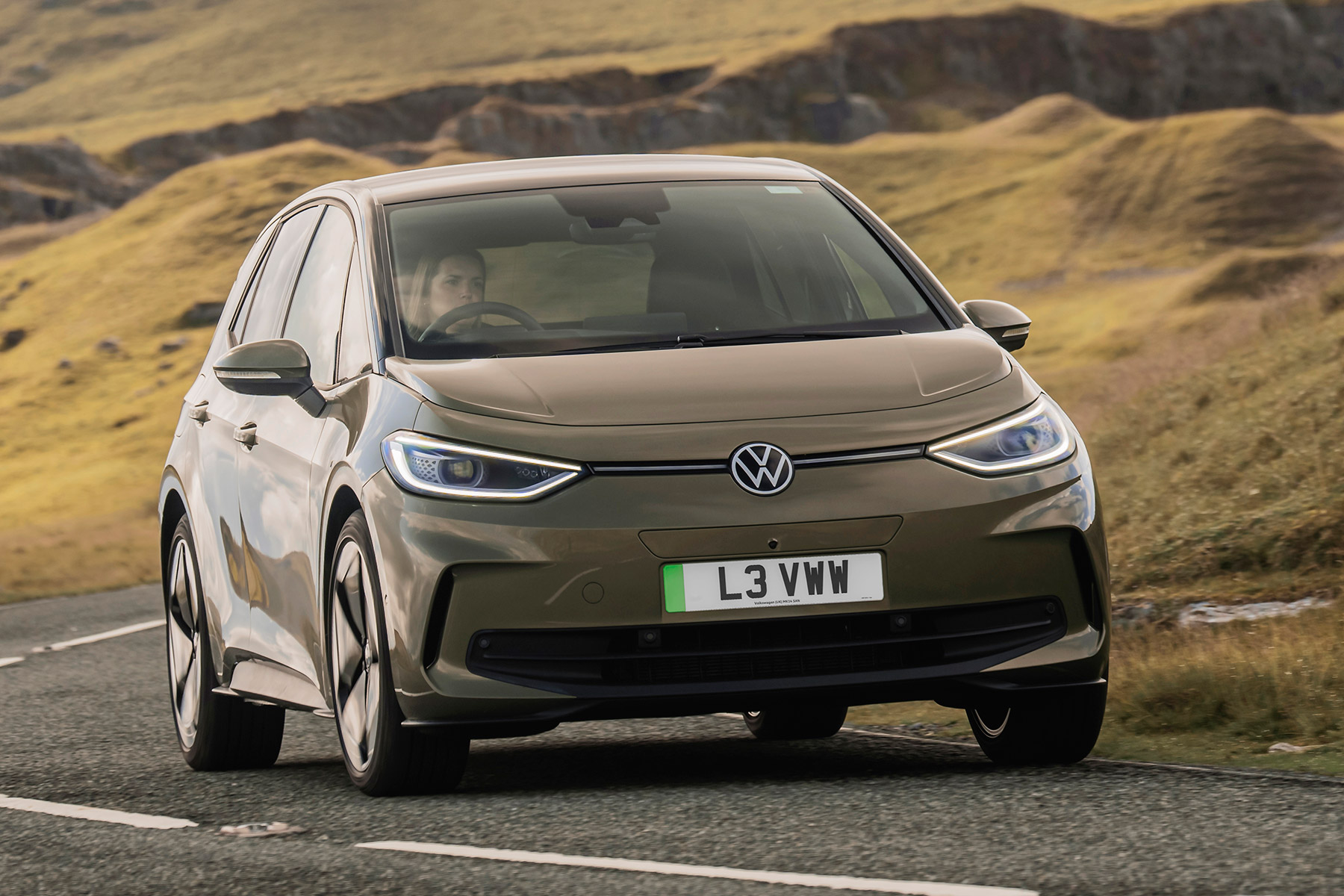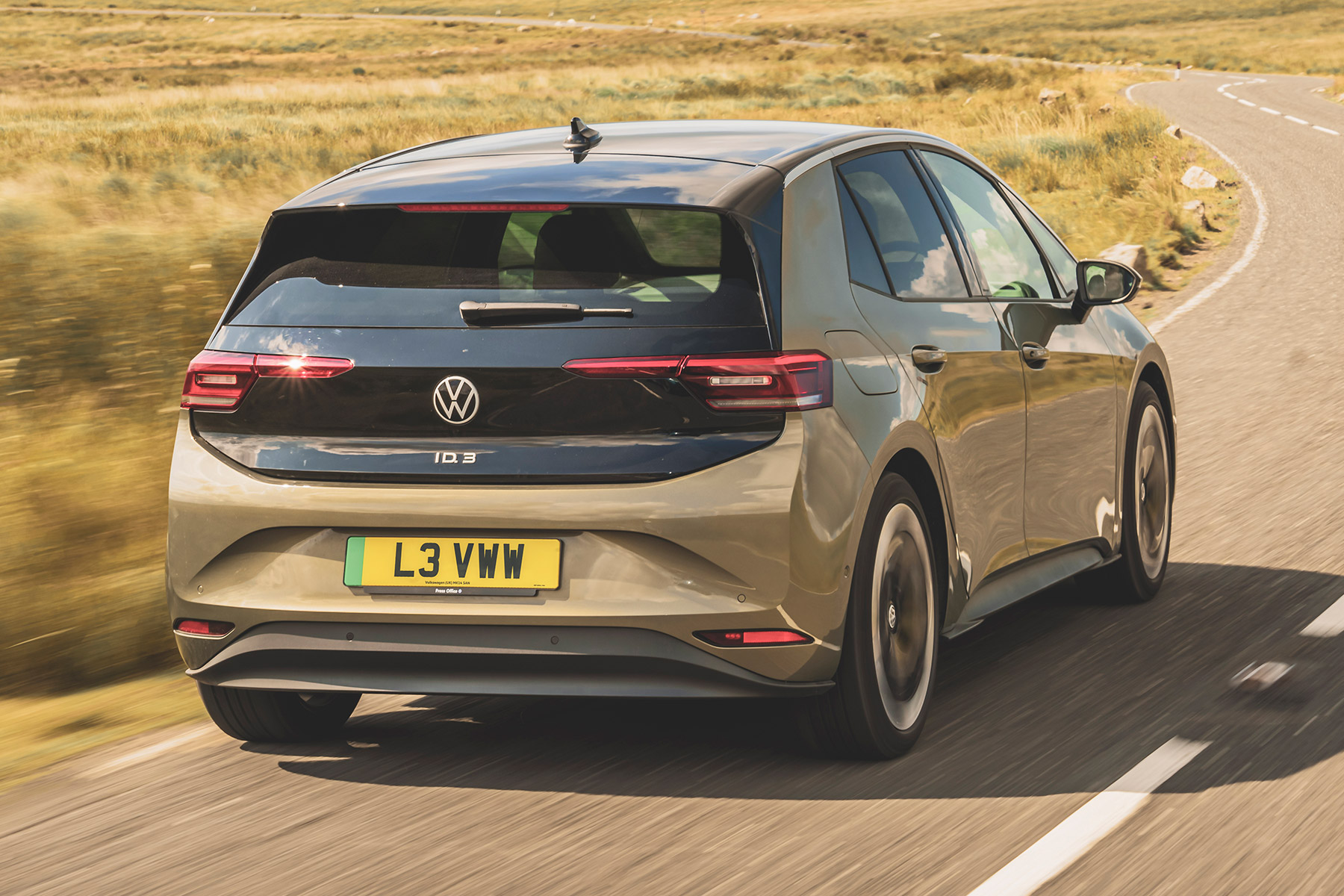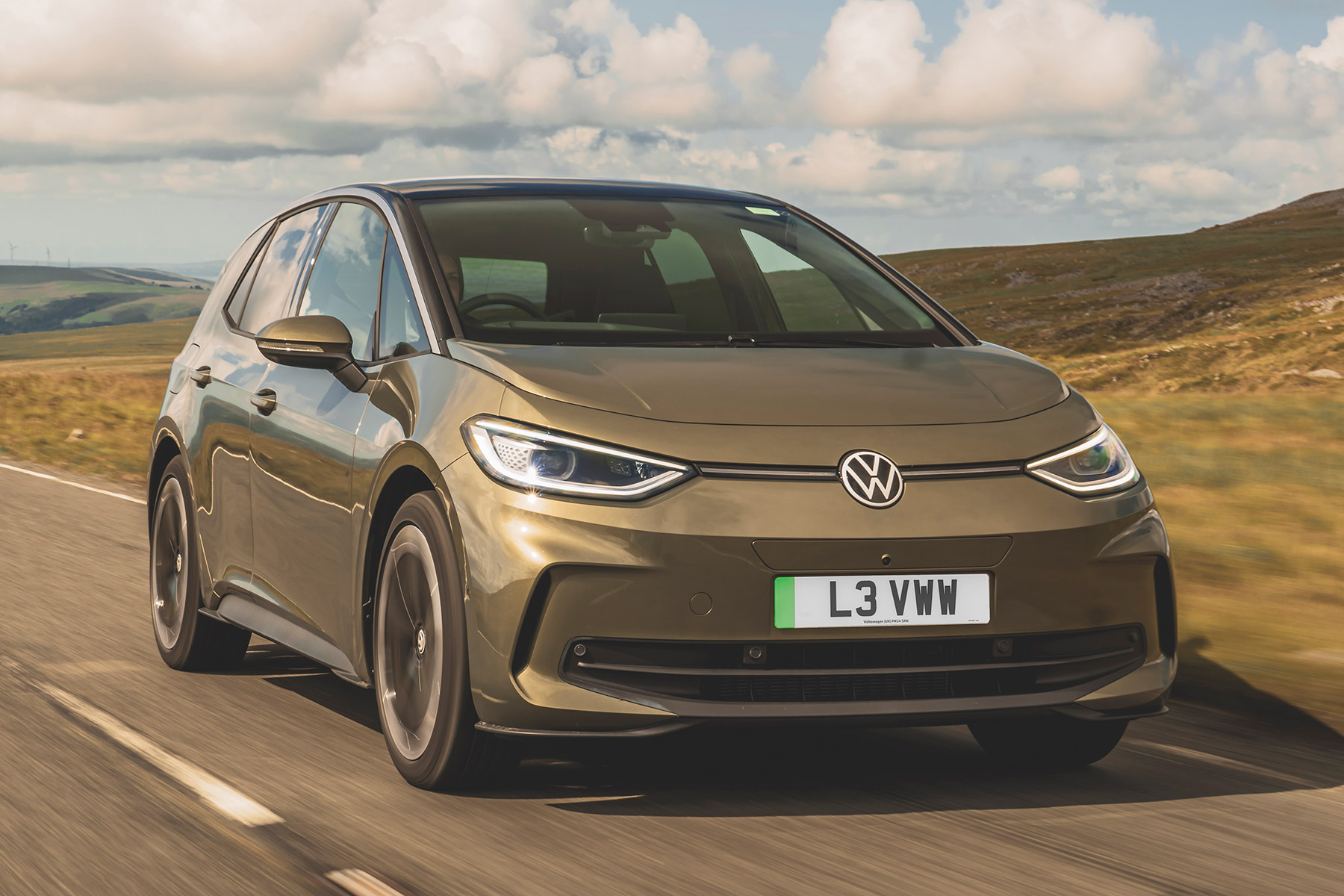Volkswagen ID.3 Review
VW's medium-sized family hatchback should offer enough range and performance to allow drivers to go electric without compromise
Strengths & weaknesses
- More spacious inside than a VW Golf
- Smooth power delivery makes it enjoyable to drive
- Impressive range from a single charge
- Some rivals have bigger boots
- Interior design a bit spartan
- Top-end ID.3s can’t match quality of upmarket rivals
The ID.3 is a significant car for VW. It’s the brand’s first electric car that’s not also based on a petrol or diesel model, and it’s aimed squarely at customers who might otherwise be thinking about a conventional petrol or diesel VW Golf.
There is still a VW Golf available - it’s a key part of the VW range - but if you’re the sort of person who wants a Golf-sized electric family car from VW, it’s an ID.3 you’ll need to go for.
Lower-spec models compete with more budget-focused electric cars like the Nissan Leaf, Citroen e-C4 and MG 5 Estate, while top-spec models are more equivalent to the Tesla Model 3, BMW i3 and Polestar 2. As ever, Volkswagen is treading a line somewhere between mainstream and premium brands. Just like it does with the Golf, really.
Entry-level cars get a 45kWh battery and a 150hp electric motor, which makes for a range of around 217 miles per charge. There’s also a 58kWh battery with a 145hp or 204hp motor, which VW claims should be able to cover up to 263 miles on a full charge. Finally, the largest battery option is the 77kWh model, which can cover up to 330 miles or so on a charge.
The ID.3's design itself is actually quite a simple shape that’s designed to maximise interior space and aerodynamic efficiency - which helps to increase how far you can travel on one charge - but VW has introduced clever colour contrasts in the panels that make the shape seem more dramatic than it is.
Unlike in the Golf, the engine - in this case the electric motor - is under the boot at the rear of the car and drives the rear wheels. This means that, despite the fact that the ID.3 is still a five-door hatchback that’s around the same size as a Golf, it actually has a lot more interior space because the front and rear wheels are able to be pushed right to the edges of the car.
One disadvantage of electric cars is that the battery packs tend to make them quite heavy. This is the case with the ID.3 - particularly the longer-range models with larger battery packs - and this means that the suspension needs to be quite stiffly sprung to cope with all that weight. The result is a car with quite a firm ride - it’s by no means overly harsh, but it’s certainly not as comfortable to ride in as a Golf.
All that weight is at least low-down in the ID.3, though, since the batteries are positioned under the floor of the car. This makes for an impressively low centre of gravity, which helps the car to feel agile on twisty roads, despite its weight.
Aside from the extra space (and possibly partly because of it), the interior seems rather spartan. This feeling isn’t helped by the digital instrument dials and the central touchscreen media system - which controls most of the car’s functions including radio, sat-nav and some of the heating controls.
It’s basically the same system as you’ll find in the Golf and although it looks swish, the lack of buttons and an operating system that’s tricky to navigate mark it down. Fortunately, the availability of Android Auto and Apple CarPlay mean you can avoid using some of the more irritating aspects of the media system, and some trim levels get jazzy interior options such as a white steering wheel to lift the ambience.
Should I get a Volkswagen ID.3?
✔ More spacious inside than a VW Golf
✔ Smooth power delivery makes it enjoyable to drive
✔ Impressive range from a single charge
✘ Some rivals have bigger boots
✘ Interior design a bit spartan
✘ Top-end ID.3s can’t match quality of upmarket rivals
The ID.3 is a truly impressive electric car - and a perfect family hatchback if you want to go electric without compromising on usability. It’s impressively well equipped in its most basic trim level (even if the design makes it look a bit basic inside), it’s remarkably good fun to drive, and it’s significantly faster than key rivals from Citroen and Kia.
The main criticism of the car is that its central touchscreen interface isn’t the most intuitive - but that's not unique to the ID.3, as it's a problem that’s also shared with the VW Golf.
If there is another weakness in the range, it’s that the top-end models with a high specification and long-range 77kWh battery don’t compare especially favourably with more upmarket-feeling cars like the Tesla Model 3. On the other hand, the fact that VW offers the ID.3 in such a broad range of price points and trim levels means that there are versions to suit a broad range of drivers.
- Trim levels
- Motor
- Batteries and range
- Charging/Charge time
- Best ID.3 for
- Rivals
- Dimensions
- Boot space
- Reliability
- Warranty
- Should I buy used?
- Deals
Which Volkswagen ID.3 to buy: trim levels
| Trim | Equipment | Deals |
| Life | Limited stock: Despite being the entry-level trim, Life is very well specified. There’s autonomous emergency braking, adaptive cruise control, heated front seats, a heated steering wheel, font and rear parking sensors and a 10-inch touchscreen media system with in-built sat-nav and Apple CarPlay/Android Auto compatibility. | |
| Style | Limited stock: Style gets privacy glass, snazzy 18-inch alloy wheels, keyless entry, matrix LED headlights (although Life models still get basic LED haedlights) and a reversing camera. | |
| Family | Limited stock: As the name implies, this trim adds in some goodies aimed at keeping the whole family happy, including dual-zone climate control and a panoramic sunroof. | |
| Max | Limited stock: Stretching to a Max trim ID.3 brings the sort of spec you’d expect from a car with a more upmarket badge. This includes wireless phone charging, massage seats, a head-up display, a premium sound system, adaptive dampers and progressive steering. | |
| Tour | Limited stock: Tour models only come with the larger battery pack. This means there are four seats instead of five, but you get all the same high-end kit you’ll find on a Max trim car, plus 19-inch alloy wheels. |
Best Volkswagen ID.3 motor

The sweet spot in the ID.3 range is almost certainly the 204hp motor. Drive it sensibly and it can be just as efficient as the lower-powered motors, yet it has the capacity for a surprising turn of speed - especially when accelerating from a standstill.
Pairing this motor with the 58kWh battery gives the best balance between range and power, too - the smaller batteries limit the range (and aren’t available with the 204hp power option), while the larger, heavier battery pack blunts the car’s performance.
Volkswagen ID.3 batteries and range
There are three different-sized battery packs available for the VW ID.3. The most affordable one is the 45kWh battery pack. This offers a claimed range of 217 miles per charge.
If you take on slightly longer journeys and want the comfort of a little extra range, then you can choose to go for the 58kWh option. This will give you a theoretical range of 263 miles from a full battery.
That’s not the biggest battery pack available, though. Pro S models get a 77kWh battery that’s good for a potential range in excess of 330 miles. That uses the same 204hp motor as the Pro performance, though, and the extra 215kg of batteries blunt the ID.3’s performance somewhat.
Whichever battery size you decide to go for, there are a number of things that you can do to help maximise the efficiency of any electric car.
Volkswagen ID.3 charging/charge time
Most ID.3 models have the capacity for 100kW charging, while the top-spec cars with the largest batteries can charge at up to 125kW. The 125kW functionality means that the car can theoretically draw enough charge for an extra 200 miles in just 30 minutes, if you can find a public charging point that’s fast enough.
With the smaller two battery packs you can expect to charge up from 10-80% battery in around half an hour on a 100kW charger, or about an hour for one of the more common 50kW charging points.
For home charging, the 58kWh model will charge from empty to full in about nine hours if you have a 7.4kW wallbox, or around seven hours if you have an 11kW installation.
Best Volkswagen ID.3 for…

The ID.3 range stretches quite a way, from providing economical electric car motoring for families on a relatively tight budget all the way to long-distance cruising machines that can rival mid-range Teslas for specification, performance and battery range. In short, there’s an ID.3 to suit almost every taste.
| Volkswagen ID.3 Pure Performance Life: 145hp and a range of just over 200 miles might be the entry point for the ID.3, but this makes a fine car for everyday family motoring, and Life trim still includes luxuries like adaptive cruise control, heated seats and even a heated steering wheel. | ||
| Volkswagen ID.3 Pro Family: The name kind of gives the game away here - VW wants this to be the model families opt for, with its family-friendly kit such as dual-zone climate control and a back-seat-pleasing panoramic sunroof. | ||
| Volkswagen ID.3 Pro Max: This features the most powerful motor (204hp) with the smaller (and therefore lighter) battery to give the best performance. And with Max trim level you get adaptive suspension and progressive steering, both of which make the ID.3 feel more agile and fun to drive. | ||
| Volkswagen ID.3 Pro S: The longest-range model in the ID.3 lineup might sound tempting, but it’s slower than the Pro, heavier and has only four seats. If you need 300-miles-plus range, a Tesla is a better bet. |
Volkswagen ID.3 rivals
At the lower end of the ID.3 range, your alternatives include the Nissan Leaf, which is a touch cheaper, but the longest-range model only delivers 238 miles of range from a full charge - and cheaper ones offer only 168 miles of claimed range. The Leaf is also a less polished-feeling car both to drive and simply to sit in.
Cheaper even than the Nissan Leaf is the MG 5, which has a range of either 214 miles or 250 miles. But while it costs less to buy, it also feels like it. Even though it’s a perfectly practical everyday electric car, the 5 feels a bit too much like a basic appliance. What’s more, it's unlikely to hold onto its value as well as the Nissan or the VW. This means that PCP finance monthly payments may not be as low as you'd expect for the MG 5, as its predicted value at the end of the contract is just as important in shaping the monthly payments as its initial price.
At the higher end of the ID.3 range, rivals include the BMW i3, which is similar to the VW in that its motor is at the rear, driving the rear wheels and the interior layout is high-tech and modern in style. There are only four seats, though, and the range is much more restrictive than you’ll get in the ID.3.
Other options to consider include the Tesla Model 3 Standard Range Plus and the Polestar 2 - the latter of which is a particularly smart and sophisticated-feeling upmarket electric car.
Volkswagen ID.3 practicality: dimensions and boot space

Volkswagen ID.3 dimensions
At just over 4.2 metres, the ID.3 is a useful few centimetres shorter than the Golf, which helps in tight parking spaces. It’s also 1.8 metres wide and 1.5 metres tall - measurements that are almost identical to the equivalent figures for the Golf - and indeed most medium-sized family hatchbacks.
Compared with electric car rivals, the ID.3 is shorter than the Tesla Model 3, but a good 20 centimetres or so longer than the BMW i3. This makes the BMW the more easy to drive car for navigating crowded city streets or manoeuvring in tight car parks, but the ID.3 is still perfectly wieldy in most urban situations.
CLICK TO READ OUR FULL STORY ON VW ID.3 DIMENSIONS
| Length 4,261mm | Width 1,809mm |
| Height 1,552mm | Weight 1,719kg |
Volkswagen ID.3 boot space
The VW ID.3 has 385 litres of boot space. That’s five litres more than you’ll find in the VW Golf, but that's such a small difference that the two models’ boots are essentially the same size. Likewise the Ford Focus - effectively a petrol and diesel rival for lower-spec ID.3s - is a similar 375 litres.
On the other hand, the Nissan Leaf’s boot can accommodate a more substantial 435 litres and the Tesla Model 3 542 litres (though its saloon body style makes the rear opening less practical than the ID.3’s hatchback). The ID.3 also beats the BMW i3 on boot space - that only has 260 litres of room.
One useful aspect of the ID.3’s boot is its adjustable floor, which you can lower to get the most boot space, or raise to create a loading area with no bootlip, meaning you can simply slide heavy objects in.
CLICK TO READ OUR FULL STORY ON VW ID.3 BOOT SPACE
| Seats up 385 litres | Seats down 1,267 litres |
Volkswagen ID.3 reliability

Volkswagens are largely reliable models, but the brand's cars aren’t up there with the best manufacturers in terms of outright dependability - they tend to rank somewhere in the middle for reliability and owner satisfaction in surveys.
With the ID.3, the advantage of the simplicity of electric car motors applies: there are fewer moving parts than with a petrol or diesel engine, so there’s less to wear out or potentially go wrong. That’s reflected in the car’s service intervals, which are an impressively long 20,000 miles, though in time terms the limit is the standard one-year interval, rather than the two-year maximum of many new cars.
Beyond electric-car reliability, the ID.3 should make for reasonably dependable family motoring.
Volkswagen ID.3 warranty
Volkswagen offers a three-year warranty with a 60,000-mile limit on its cars. That’s more or less on par with the industry standard, but not as good as the seven-year warranties offered by Kia, SsangYong and MG. Toyota warranties can last longer from new, too, with up to 10 years of protection available, while manufacturers such as Hyundai offer five years.
Where the VW warranty does compare well is by offering unlimited-mileage cover for the first two years - which is great for drivers who cover many tens of thousands of miles per year, as you can potentially benefit from cover that lasts more than 60,000 miles.
An important aspect of an electric car warranty is the battery cover, and in the case of the ID.3, you’ll be covered for eight years or 100,000 miles - whichever comes first.
Overall coverage excludes all the usual wear-and-tear items such as brakes, tyres and suspension, but VW will cover these for the first six months or 6,500 miles. The same short-term warranty protection applies to mechanical adjustments.
| 3 years | 60,000 miles |
AVERAGE VOLKSWAGEN REPAIR COST PAID BY WARRANTYWISE: £537
CLICK HERE FOR MORE INFORMATION ON USED CAR WARRANTIES
Used Volkswagen ID.3: should I buy one?
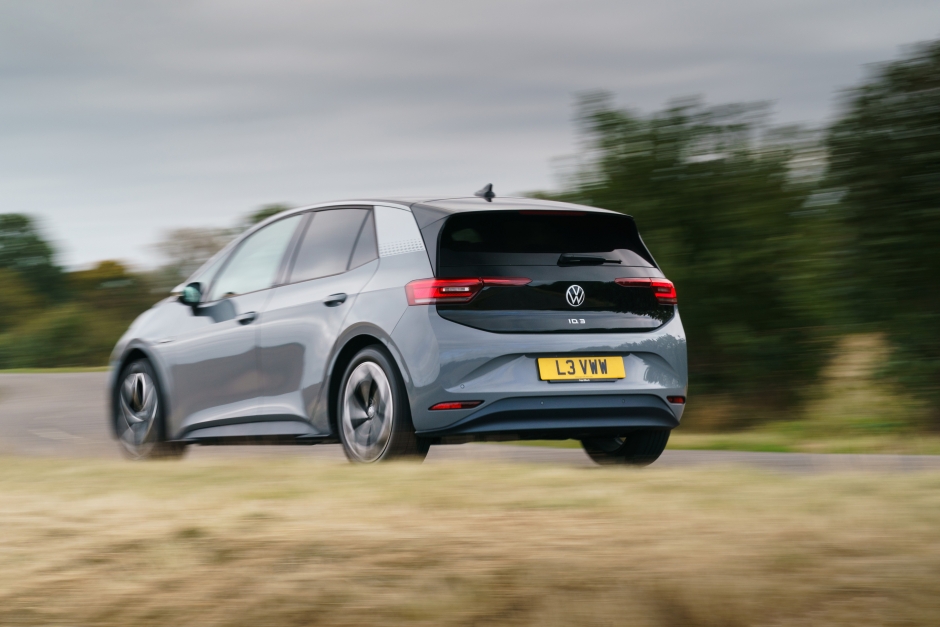
Used examples of the ID.3 are relatively thin on the ground and pricing can be a bit inconsistent as electric vehicles are still a bit of an unknown quantity on the used market. This means that PCP finance deals on used models can vary quite a lot in terms of costs.
However, the simplicity of the ID.3’s mechanical parts should count in its favour. In essence, because there are fewer complex components in an electric car than an equivalent petrol or diesel model, they should make a very appealing choice as a used car.
On top of this, the fact that the ID.3 has an extensive dealer network to support it should provide extra peace of mind when it comes to servicing or having any warranty repair work carried out.
Best Volkswagen ID.3 deals
In many respects there’s no need to delve beyond the entry-level Life trim, as it’s so well equipped, with its 10-inch touchscreen media system, digital dials, digital radio, adaptive cruise control and heated front seats. You can get all three motor power options with Life trim, plus either the 45kWh or 58kWh battery.
If you want as much range as possible, the Pro S Tour is the sensible option, but it is pricey, so do consider other electric options from the likes of Polestar or Tesla.
Really, Max and Tour trim cars are relatively expensive for what they are, so unless you specifically are looking for all the extra goodies and styling tweaks, then these aren’t really worth going for.
Overall though, the broad range of trim levels, battery pack sizes and motor options means there should be an ID.3 out there to suit your personal tastes and budget.
*Representative PCP finance - 2018 Ford Fiesta 1.0 ST-Line Hatchback:
| PCP representative example | APR rates available | |||||
| Cash price £12,000 | APR 7.90% | Value of loan | From | |||
| Fixed monthly payment £218.12 | Annual mileage of 8,000pa | £25,000+ | 6.9% | |||
| Total cost of credit £2,755.55 | Term 48 months | £12,000-£24,999 | 7.9% | |||
| Optional final payment £4,285.79 | Loan value £12,000 | £8,000-£11,999 | 8.9% | |||
| Total amount payable £14,755.55 | Deposit £0 | <8,000 | 9.9% |
BuyaCar is a credit broker, not a lender. Our rates start from 6.9% APR. The rate you are offered will depend on your individual circumstances.




